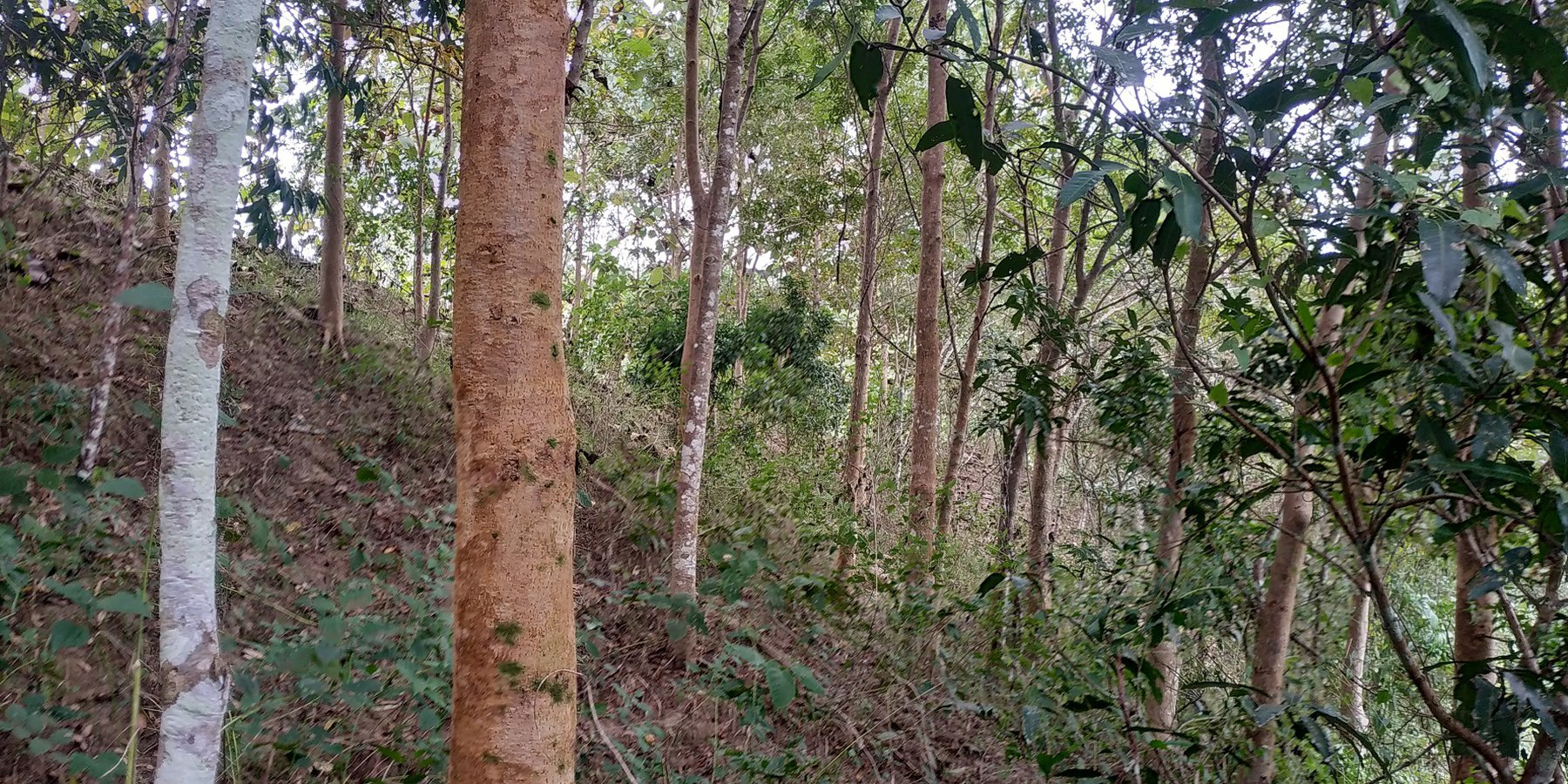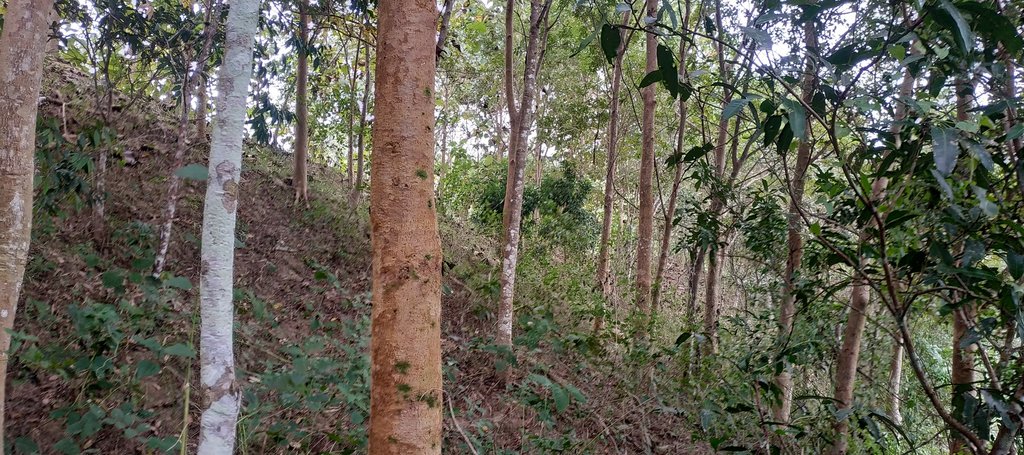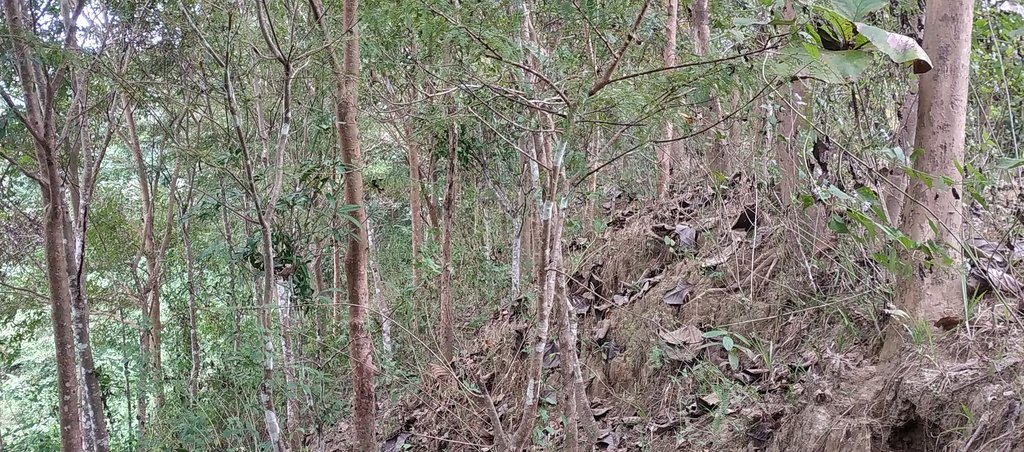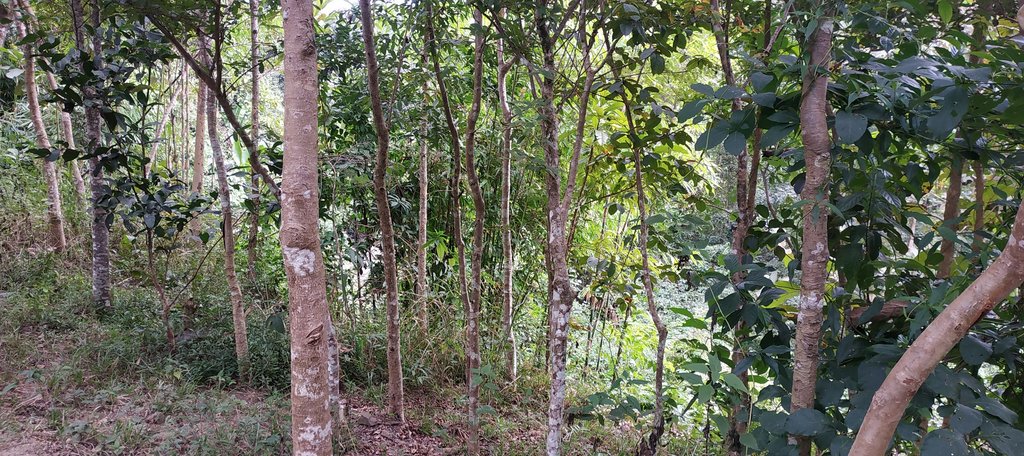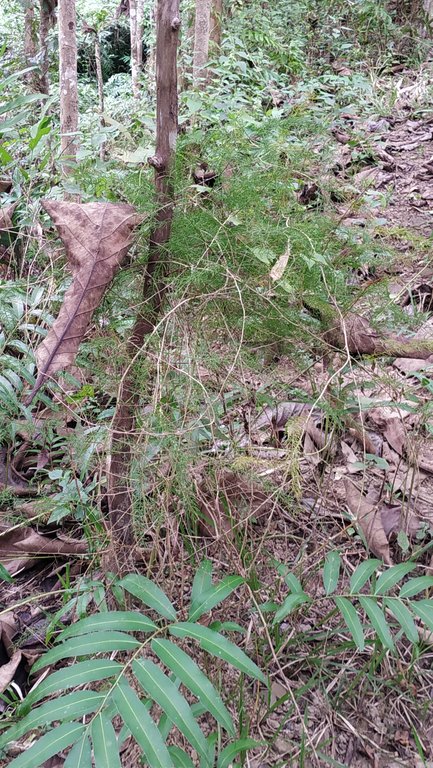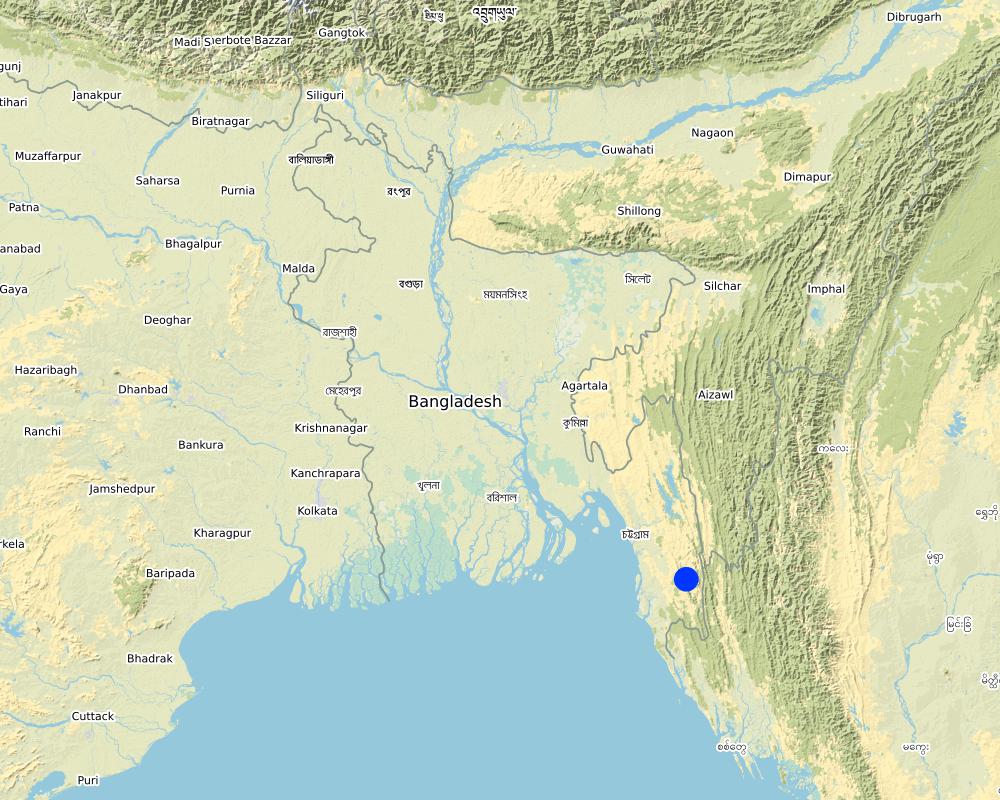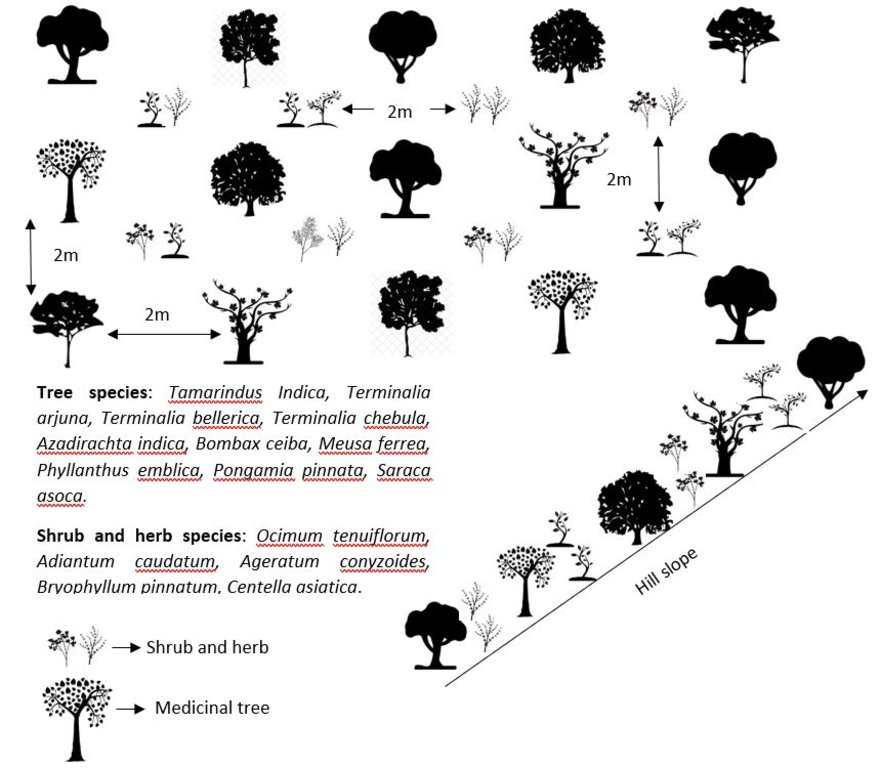Protection from land degradation through conservation of medicinal plants by involving ethnic communities. [ប្រទេសបង់ក្លាដែស]
- ការបង្កើត៖
- បច្ចុប្បន្នភាព
- អ្នកចងក្រង៖ Fazlay Arafat
- អ្នកកែសម្រួល៖ Mutasim Billah, Md. Arfanuzzaman
- អ្នកត្រួតពិនិត្យច្រើនទៀត៖ Nicole Harari, Rima Mekdaschi Studer, Ursula Gaemperli
Herbal medicine plantation to stop land degradation
technologies_4287 - ប្រទេសបង់ក្លាដែស
ពិនិត្យមើលគ្រប់ផ្នែក
ពង្រីកមើលទាំងអស់ បង្រួមទាំងអស់1. ព័ត៌មានទូទៅ
1.2 ព័ត៌មានលម្អិតពីបុគ្គលសំខាន់ៗ និងស្ថាប័នដែលចូលរួមក្នុងការវាយតម្លៃ និងចងក្រងឯកសារនៃបច្ចេកទេស
បុគ្គលសំខាន់ម្នាក់ (ច្រើននាក់)
អ្នកប្រើប្រាស់ដី:
Thoai Uba
Bolipara Nari Kalyan Somity (BNKS)
ប្រទេសបង់ក្លាដែស
អ្នកប្រើប្រាស់ដី:
Shing Nue Hla
Bolipara Nari Kalyan Somity (BNKS)
ប្រទេសបង់ក្លាដែស
ឈ្មោះគម្រោងដែលបានចងក្រងឯកសារ/ វាយតម្លៃលើបច្ចេកទេស (បើទាក់ទង)
Decision Support for Mainstreaming and Scaling out Sustainable Land Management (GEF-FAO / DS-SLM)ឈ្មោះអង្គភាពមួយ (ច្រើន) ដែលបានចងក្រងឯកសារ/ វាយតម្លៃបច្ចេកទេស (បើទាក់ទង)
FAO Bangladesh (FAO Bangladesh) - ប្រទេសបង់ក្លាដែសឈ្មោះអង្គភាពមួយ (ច្រើន) ដែលបានចងក្រងឯកសារ/ វាយតម្លៃបច្ចេកទេស (បើទាក់ទង)
IUCN-The World Conservation Union (IUCN-The World Conservation Union) - ប្រទេសបង់ក្លាដែស1.3 លក្ខខណ្ឌទាក់ទងទៅនឹងការប្រើប្រាស់ទិន្នន័យដែលបានចងក្រងតាមរយៈ វ៉ូខេត
អ្នកចងក្រង និង(បុគ្គលសំខាន់ៗ)យល់ព្រមទទួលយកនូវលក្ខខណ្ឌនានាទាក់ទងទៅនឹងការប្រើប្រាស់ទិន្នន័យដែលបានចងក្រងតាមរយៈវ៉ូខេត:
បាទ/ចា៎
1.4 សេចក្តីប្រកាសស្តីពីចីរភាពនៃការពណ៌នាពីបច្ចេកទេស
តើបច្ចេកទេសដែលបានពណ៌នានេះមានបញ្ហាដែលផ្តោតលើការធ្លាក់ចុះគុណភាពដី, បើដូច្នេះវាមិនអាចត្រូវបានប្រកាសថាជាបច្ចេកទេសនៃការគ្រប់គ្រងប្រកបដោយចីរភាពទេ?
ទេ
2. ការពណ៌នាពីបច្ចេកទេស SLM
2.1 ការពណ៌នាដោយសង្ខេបពីបច្ចេកទេស
និយមន័យបច្ចេកទេស:
The indigenous community in Bolipara village of the Thanchi upazlia (sub-district) of the Bandarban district are reducing or preventing land degradation through the cultivation and conservation of medicinal plants. This practice provides the raw material needed, by local traditional healers, to produce herbal medicines for the indigenous and tribal peoples.
2.2 ការពណ៌នាលម្អិតពីបច្ចេកទេស
ការពណ៌នា:
The Chittagong Hill Tracts (CHT) are well-renowned for its unique physiography that harbors rich biodiversity, and for its distinct and rich culture, traditional, and customary practices because of the predominance of many indigenous communities. It is also one of the few remaining areas in Bangladesh where traditional environmental knowledge (TEK) plays an important part in the daily life and customary practices of indigenous communities. Medicinal plants, of course, are a key component of the local health care system. However, the production and use of traditional medicines (mostly herbal in nature) substantively declined as medicinal plants have become rarer – this is due to rapid changes in land use patterns driven by population growth and economic trends. The risk that interest in and local knowledge of medicinal plant use will reduce or even disappear over time as has occurred in other parts of the world, changing the very nature of indigenous life. Land degradation is another major ecological concern for this area. Shifting cultivation with curtailed fallow periods, deforestation, and unplanned cultivation along the hill slopes has caused land degradation in Bolipara union. It is located in Thanchi upazila (longitude 21º78´, latitude 92º42´) under Bandarban hill district of Bangladesh. The total population of the union is more than 10,000. The ethnic communities living in the area include Bowm, Chakma, Khumi, Marma, Mru, Tripura and Chack. Most of the family depends on agriculture and horticulture for their livelihood. BNKS (Bolipara Nari Kalyan Somity) is an NGO who work here to promote the socio-economic and cultural status of the marginalized and socially excluded peoples. ‘Bolipara Kobiraj Kalyan Somiti’ is another local institution of traditional herbal healers.
In 2008, International Union for Conservation of Nature (IUCN) took the initiative to reduce and prevent land degradation in Bolipara through the cultivation and conservation of medicinal plants by indigenous communities. While forest conversion reduces the diversity and availability of medicinal plants, reforestation with medicinal plants can promote and accelerate forest succession on a previously deforested site. As a part of the IUCN project, medicinal tree species like Tamarindus indica, Terminalia arjuna, Terminalia bellerica, Terminalia chebula, Azadirachta indica, Bombax ceiba, Meusa ferrea, Phyllanthus emblica, Pongamia pinnata, and Saraca asoca were planted on the degraded slopes with a 2m x 2m spacing. In between the tree lines, shrub and herb species like Ocimum tenuiflorum, Adiantum caudatum, Ageratum conyzoides, Bryophyllum pinnatum, and Centella asiatica were planted with same spacing in a crisscross manner. The establishment of medicinal plants requires various inputs and extension services from medicinal plant nurseries to demonstration sites and the engagement of communities and community groups (please see more details under the download link: https://portals.iucn.org/library/node/9589).
In this instance, the planting and conservation of medicinal plants was conducted under the supervision of Buddhist monks (from local temples) and ‘Bolipara Kobiraj Kalyan Somiti’(BNKS). The local community were involved with Nursery preparation (seed collection, bed preparation, poly-bag preparation, manuring, irrigation, etc.), preparation of plantation site (jungle cutting, debris collection, preparation of inspection paths, etc.), plantation activities (pit preparation, tying up of plants with sticks for support, application of fertilizers, compost and biocide, etc.) and maintenance activities (vacancy filing, weeding, fertilizer application, etc.). After the medicinal plantation was established in 2008, the degraded land started to regain its health since trees and plants positively influenced the understory microclimate, the structural complexity of vegetation, and the development of humus layer. The indigenous medicinal plants and trees, because of their deep roots, also reduced topsoil erosion, and prevented gully erosion formation. Currently, the site is observed to have good canopy cover, and functions as a good habitat for a number of bird species and monkeys. The local herbal healers have the access to the plantation site and are able to obtain the raw materials needed to produce their medicines in short periods of time and with less effort. The local community people can collect dry leaves and dead branches from the plantation for firewood. This technology is simple enough to implement by the local people without any need of external financial and technical support. The local herbal healers have to collect raw materials to prepare their medicines.
Medicinal plants are an important component of Bangladesh’s national wealth. Even as they serve as important therapeutic agents in various traditional and modern medicines, our understanding of their abundance, distribution, and novel pharmaceutical compounds is poor. The planting/cultivation and conservation of medicinal plants and adequate engagement of local indigenous communities of Bolipara village is a good example of an action that can promote sustainability in all its dimensions (reduced land degradation, social and economic well-being through increase in raw material availability for traditional healers, etc.). Lack of marketing channel of medicinal raw materials and lack of scientific knowledge and tools for medicinal raw materials handling is a potential threat for sustaining the technology in the long run. The capacities of the local herbal healers can be strengthened through training and the marketing channel can be improved through engaging private sector in traditional medicine value chain.
2.3 រូបភាពនៃបច្ចេកទេស
2.5 ប្រទេស/តំបន់/ទីតាំងកន្លែង ដែលបច្ចេកទេសត្រូវបានអនុវត្ត និងបានគ្រប់ដណ្តប់ដោយការវាយតម្លៃនេះ
ប្រទេស:
ប្រទេសបង់ក្លាដែស
តំបន់/រដ្ឋ/ខេត្ត:
Bandarban
បញ្ជាក់បន្ថែមពីលក្ខណៈនៃទីតាំង:
Bolipara village, Thanchi
បញ្ជាក់ពីការសាយភាយនៃបច្ចេកទេស:
- ត្រូវបានផ្សព្វផ្សាយត្រឹមតំបន់មួយ
ប្រសិនបើមិនច្បាស់ពីទំហំផ្ទៃដី សូមធ្វើការប៉ាន់ប្រម៉ាណ:
- < 0.1 គម2 (10 ហិកតា)
តើបច្ចេកទេស (មួយ ឬច្រើន) ទាំងនោះស្ថិតនៅក្នុងតំបន់ការពារជាអចិន្ត្រៃយ៍ណាមួយដែរឬទេ?
ទេ
Map
×2.6 កាលបរិច្ឆេទនៃការអនុវត្ត
បង្ហាញឆ្នាំនៃការចុះអនុវត្ត:
2008
2.7 ការណែនាំពីបច្ចេកទេស
សូមបញ្ជាក់តើបច្ចេកទេសត្រូវបានណែនាំឱ្យអនុវត្តដោយរបៀបណា:
- តាមរយៈគម្រោង / អន្តរាគមន៍ពីខាងក្រៅ
មតិយោបល់ (ប្រភេទនៃគម្រោង ។ល។):
"Conservation Through Practices" project implemented by IUCN Bangladesh and BNKS. The main objective of the project was to conserve medicinal plants in degraded land areas by the supervision of Monks in Buddhist temples.
3. ចំណាត់ថ្នាក់នៃបច្ចេកទេស SLM
3.1 គោលបំណងចម្បង (១ ឬច្រើន) នៃបច្ចេកទេសនេះ
- ធ្វើឱ្យប្រសើរឡើងនូវផលិតកម្ម
- កាត់បន្ថយ, បង្ការ, ស្តារឡើងវិញនូវការធ្លាក់ចុះគុណភាពដី
- អភិរក្ស/ធ្វើឱ្យប្រសើរឡើងជីវចម្រុះ
- បង្កើតផលប្រយោជន៍សេដ្ឋកិច្ច
- បង្កើតផលប្រយោជន៍សង្គម
3.2 ប្រភេទដីប្រើប្រាស់មួយប្រភេទ (ច្រើនប្រភេទ) ដែលបានអនុវត្តបច្ចេកទេស
ដីប្រើប្រាស់ចម្រុះនៅលើដីតែមួយ:
ទេ

ដីព្រៃ/ដីដាំដើមឈើ
- ការដាំដើមឈើ ការដាំព្រៃឡើងវិញ
ការដាំដើមឈើ ការដាំដើមឈើឡើងវិញ៖ បញ្ជាក់ពីប្រភេទក្នុងតំបន់ និងប្រភេទលុប:
- ពូជបញ្ចូលគ្នា
ប្រភេទដើមឈើដែលដាំនៅកន្លែងដែលមិនធ្លាប់មានឈើពីមុន :
- ព្រៃសើមដាំតំបន់ពាក់កណ្តាលត្រូពិច - ឈើស្លឹកធំ
- Tamarindus Indica, Terminalia arjuna, Terminalia bellerica, Terminalia chebula, Azadirachta indica, Bombax ceiba, Meusa ferrea, Phyllanthus emblica, Pongamia pinnata, Saraca asoca, Ocimum tenuiflorum, Adiantum caudatum, Ageratum conyzoides, Bryophyllum pinnatum, Centella asiatica.
តើប្រភេទឈើខាងលើជាប្រភេទឈើក្នុងព្រៃល្បោះ ឬស្រោង?
- ព្រៃស្រោង
ផលិតផល និងសេវាកម្ម:
- ឈើហ៊ុប
- អុស
- ផ្លែឈើ និងគ្រាប់ធញ្ញជាតិ
- ផលិតផលព្រៃផ្សេងៗ
- ការអភិរក្ស/ការការពារធម្មជាតិ
- ការកំសាន្ត/ទេសចរណ៍
- Herbal Medicine
3.3 បន្ទាប់ពីអនុវត្តបច្ចេកទេស តើដីប្រើប្រាស់មានការប្រែប្រួលដែររឺទេ?
បន្ទាប់ពីអនុវត្តបច្ចេកទេស តើដីប្រើប្រាស់មានការប្រែប្រួលដែររឺទេ?
- បាទ/ច៎ា (សូមបំពេញសំណួរខាងក្រោមពីស្ថានភាពដីប្រើប្រាស់មុនពេលអនុវត្តបច្ចេកទេស)
ដីប្រើប្រាស់ចម្រុះនៅលើដីតែមួយ:
ទេ

ដីខ្សោះជីជាតិ
សូមបញ្ជាក់:
The hill slope remains barren other than covered by some natural herbs and shrubs.
កំណត់សម្គាល់:
Soil erosion and land slide was a common phenomena in that area.
3.4 ការផ្គត់ផ្គង់ទឹក
ការផ្គត់ផ្គង់ទឹកនៅកន្លែងអនុវត្តបច្ចេកទេស:
- ទឹកភ្លៀង និងប្រព័ន្ធស្រោចស្រព
3.5 ក្រុម SLM ដែលបច្ចេកទេសស្ថិតនៅក្នុង
- គ្រប់គ្រងការដាំព្រៃឈើ
- ធ្វើឱ្យប្រសើរឡើងគម្របដី/ ដំណាំគម្របដី
- ធ្វើឱ្យប្រសើរឡើងនូវការបង្កាត់ពូជរុក្ខជាតិ/ សត្វ
3.6 វិធានការ SLM ដែលបញ្ចូលនូវបច្ចេកទេស

វិធានការរុក្ខជាតិ
- V1: ឈើធំៗ និងដើមឈើតូចៗ
3.7 កំណត់ប្រភេទនៃការធ្លាក់ចុះគុណភាពដីសំខាន់ៗដែលបច្ចេកទេសនេះបានដោះស្រាយ

ការហូរច្រោះដីដោយសារទឹក
- Wt: ការបាត់ដីស្រទាប់លើដោយការហូរច្រោះ
- Wm: ការបាក់ដី

ការធ្លាក់ចុះជីវសាស្ត្រនៃដី
- Bc: ការថយចុះនូវគម្របរុក្ខជាតិ
- Bs: សមាសភាពដែលមានគុណភាពនិងប្រភេទសត្វ/ការថយចុះនូវជីវចម្រុះ
3.8 ការពារ កាត់បន្ថយ ឬស្តារឡើងវិញនៃការធ្លាក់ចុះគុណភាពដី
បញ្ជាក់ពីគោលដៅរបស់បច្ចេកទេស ដែលផ្តោតទៅការធ្លាក់ចុះគុណភាពដី:
- ការកាត់បន្ថយការធ្លាក់ចុះគុណភាពដី
4. បច្ចេកទេសជាក់លាក់ សកម្មភាពអនុវត្ត ធាតុចូល និងថ្លៃដើម
4.1 គំនូសបច្ចេកទេសនៃបច្ចេកទេសនេះ
លក្ខណៈពិសេសនៃបច្ចេកទេស (ទាក់ទងនឺងគំនូរបច្ចេកទេស):
Dimension of plantation: across the slope;
Spacing between Tree species: 2m X 2m;
Spacing between Shrub and herb species: 2m X 2m;
shrub and herb species planted in between tree lines with crisscross manner
ឈ្មោះអ្នកនិពន្ធ:
Md. Fazlay Arafat
កាលបរិច្ឆេទ:
21/04/2019
4.2 ព័ត៌មានទូទៅដែលពាក់ព័ន្ធនឹងការគណនាធាតុចូល និងថ្លៃដើម
កំណត់របៀបនៃការគណនាថ្លៃដើម និងធាតុចូល:
- ក្នុងតំបន់អនុវត្តបច្ចេកទេស
កំណត់ទំហំ និងឯកត្តាផ្ទៃដី:
1 hectare
បើសិនប្រើឯកតាតាមតំបន់ សូមបញ្ជាក់តម្លៃបម្លែងវាទៅជាហិកតា (ឧ. 1 ហិកតា = 2.47 អា)៖ 1 ហិកតា =:
2.47 acres
ផ្សេងៗ/ រូបិយប័ណ្ណជាតិ (បញ្ជាក់):
BDT
បើពាក់ព័ន្ធសូមកំណត់អត្រាប្តូរប្រាក់ពីដុល្លាទៅរូបិយប័ណ្ណតំបន់ (ឧ. 1 ដុល្លារ = 79.9 រៀលនៃរូបិយប័ណ្ណប្រេស៊ីល) ៖ 1 ដុល្លារ =:
83,0
កំណត់ថ្លៃឈ្នួលជាមធ្យមនៃការជួលកម្លាំងពលកម្មក្នុងមួយថ្ងៃ:
BDT 500
4.3 សកម្មភាពបង្កើត
| សកម្មភាព | រយៈពេល (រដូវកាល) | |
|---|---|---|
| 1. | Nursery preparation (seed collection, site clearing, leveling and fencing, drainage arrangement, bed preparation, making overhead shed, poly-bag preparation, potting seeds, manuring, irrigation, weed control) | September-October |
| 2. | Site preparation (boundary demarcation, jungle cutting, debris collection and staging, preparation of inspection paths and fire lines) | May-June |
| 3. | Plantation (pit preparation, tying up of plants, application of fertilizers, compost and biocide, stick for support) | June-July |
4.4 ថ្លៃដើម និងធាតុចូលដែលត្រូវការសម្រាប់ការបង្កើតបច្ចេកទេស
| បញ្ជាក់ពីធាតុចូល | ឯកតា | បរិមាណ | ថ្លៃដើមក្នុងមួយឯកតា | ថ្លៃធាតុចូលសរុប | % នៃថ្លៃដើមដែលចំណាយដោយអ្នកប្រើប្រាស់ដី | |
|---|---|---|---|---|---|---|
| កម្លាំងពលកម្ម | Nursery preparation (seed collection, site clearing, leveling and fencing, drainage arrangement, bed preparation, making overhead shed, poly-bag preparation, potting seeds, manuring, irrigation, weed control) | person-days | 25,0 | 500,0 | 12500,0 | 100,0 |
| កម្លាំងពលកម្ម | Plantation site preparation (boundary demarcation, jungle cutting, debris collection and staging, preparation of inspection paths and fire lines) | person-days | 13,0 | 500,0 | 6500,0 | 100,0 |
| កម្លាំងពលកម្ម | Plantation (pit preparation, tying up of plants, application of fertilizers, compost and biocide, stick for support) | person-days | 27,0 | 500,0 | 13500,0 | 100,0 |
| សម្ភារៈ | Poly-bags | pieces | 3000,0 | 1,0 | 3000,0 | |
| សម្ភារៈ | Bamboo for shed and bed edging | pieces | 6,0 | 250,0 | 1500,0 | |
| សម្ភារៈ | Nursery equipment (Bucket, spade, scissor, knife etc.) | Lump sum | 1,0 | 600,0 | 600,0 | |
| សម្ភារៈដាំដុះ | Procure and transport of loamy soil for filling 3000 poly-bags (17.78cmX1270cm ) | Cubic Meter | 3,0 | 400,0 | 1200,0 | |
| សម្ភារៈដាំដុះ | Seed purchase | Kg | 3,0 | 500,0 | 1500,0 | |
| សម្ភារៈដាំដុះ | Bamboo stick for tying up of plants | pieces | 2600,0 | 2,0 | 5200,0 | |
| ជី និងសារធាតុពុល | Compost | Kg | 700,0 | 4,0 | 2800,0 | |
| ជី និងសារធាតុពុល | Urea | Kg | 15,0 | 35,0 | 525,0 | |
| ជី និងសារធាតុពុល | TSP | Kg | 15,0 | 40,0 | 600,0 | |
| ជី និងសារធាតុពុល | MOP | Kg | 15,0 | 30,0 | 450,0 | |
| ជី និងសារធាតុពុល | Biocide | Lump Sum | 1,0 | 200,0 | 200,0 | |
| សម្ភារៈសាងសង់ | Signboard (for demarcation of plantation site) | Lump Sum | 1,0 | 1000,0 | 1000,0 | 100,0 |
| ថ្លៃដើមសរុបក្នុងការបង្កើតបច្ចេកទេស | 51075,0 | |||||
| ថ្លៃដើមសរុបក្នុងការបង្កើតបច្ចេកទេសគិតជាដុល្លារ | 615,36 | |||||
មតិយោបល់:
Traditional local healers and Buddhist monks of Bolipara are the land user here. The project of IUCN Bangladesh titled as, ‘One Stop Service: facilitating conservation of medicinal plant and traditional health service to ethnic communities of Chittagong Hill Tracts (CHT) Bangladesh’ covered some cost of the technology.
4.5 សកម្មភាពថែទាំ
| សកម្មភាព | ពេលវេលា/ ភាពញឹកញាប់ | |
|---|---|---|
| 1. | Vacancy filing | June-July |
| 2. | Tying up of plants | June-July |
| 3. | Fertilizer application | June-July |
| 4. | Weeding | Three times in a year |
4.6 កំណត់ថ្លៃដើមសម្រាប់ការថែទាំ/ សកម្មភាពរបស់បច្ចេកទេស (ក្នុងរយៈពេលមួយឆ្នាំ)
| បញ្ជាក់ពីធាតុចូល | ឯកតា | បរិមាណ | ថ្លៃដើមក្នុងមួយឯកតា | ថ្លៃធាតុចូលសរុប | % នៃថ្លៃដើមដែលចំណាយដោយអ្នកប្រើប្រាស់ដី | |
|---|---|---|---|---|---|---|
| កម្លាំងពលកម្ម | Vacancy filling | Person-days | 6,0 | 500,0 | 3000,0 | 100,0 |
| កម្លាំងពលកម្ម | Tying up of plants | Person-days | 1,0 | 500,0 | 500,0 | 100,0 |
| កម្លាំងពលកម្ម | Fertilizer application | Person-days | 5,0 | 500,0 | 2500,0 | 100,0 |
| កម្លាំងពលកម្ម | Weeding (3 times) | Person-days | 18,0 | 500,0 | 9000,0 | 100,0 |
| សម្ភារៈដាំដុះ | Bamboo stick for tying up of plants | pieces | 550,0 | 2,0 | 1100,0 | |
| សម្ភារៈដាំដុះ | Seedling | pieces | 500,0 | 5,0 | 2500,0 | 100,0 |
| ជី និងសារធាតុពុល | NPK fertilizer | Kg | 125,0 | 30,0 | 3750,0 | |
| ថ្លៃដើមសរុបសម្រាប់ការថែទាំដំណាំតាមបច្ចេកទេស | 22350,0 | |||||
| ថ្លៃដើមសរុបសម្រាប់ការថែទាំដំណាំតាមបច្ចេកទេសគិតជាដុល្លារ | 269,28 | |||||
ប្រសិនបើអ្នកប្រើប្រាស់ដីមិនមានថ្លៃដើម 100% សូមបញ្ជាក់ថានរណាដែលចំណាយថ្លៃដើមដែលនៅសល់:
The project "One Stop Service: facilitating conservation of medicinal plant and traditional health service to ethnic communities of Chittagong Hill Tracts (CHT) Bangladesh" covered some maintenance cost of the plantation.
4.7 កត្តាសំខាន់បំផុតដែលមានឥទ្ធិពលដល់ការចំណាយ
ពណ៌នាពីកត្តាប៉ះពាល់ចម្បងៗទៅលើថ្លៃដើម:
Labor cost
5. លក្ខណៈបរិស្ថានធម្មជាតិ និងមនុស្ស
5.1 អាកាសធាតុ
បរិមាណទឹកភ្លៀងប្រចាំឆ្នាំ
- < 250 មម
- 251-500 មម
- 501-750 មម
- 751-1,000 មម
- 1,001-1,500 មម
- 1,501-2,000 មម
- 2,001-3,000 មម
- 3,001-4,000 មម
- > 4,000 មម
កំណត់បរិមាណទឹកភ្លៀង (បើដឹង) ជា មីលីម៉ែត្រ:
2528,00
តំបន់កសិអាកាសធាតុ
- មានភ្លៀងមធ្យម
Mean annual temperature is 25.9 °C
5.2 សណ្ឋានដី
ជម្រាលជាមធ្យម:
- រាបស្មើ (0-2%)
- ជម្រាលតិចតួច (3-5%)
- មធ្យម (6-10%)
- ជម្រាលខ្ពស់បន្តិច (11-15%)
- ទីទួល (16-30%)
- ទីទួលចោត (31-60%)
- ទីទួលចោតខ្លាំង (>60%)
ទម្រង់ដី:
- ខ្ពង់រាប
- កំពូលភ្នំ
- ជម្រាលភ្នំ
- ជម្រាលទួល
- ជម្រាលជើងភ្នំ
- បាតជ្រលងភ្នំ
តំបន់តាមរយៈកម្ពស់ :
- 0-100 ម
- 101-500 ម
- 501-1,000 ម
- 1,001-1,500 ម
- 1,501-2,000 ម
- 2,001-2,500 ម
- 2,501-3,000 ម
- 3,001-4,000 ម
- > 4,000 ម
បញ្ជាក់ថាតើបច្ចេកទេសនេះត្រូវបានអនុវត្តន៍នៅក្នុង:
- សណ្ឋានដីប៉ោង
5.3 ដី
ជម្រៅដីជាមធ្យម:
- រាក់ខ្លាំង (0-20 សម)
- រាក់ (21-50 សម)
- មធ្យម (51-80 សម)
- ជ្រៅ (81-120 សម)
- ជ្រៅខ្លាំង (> 120 សម)
វាយនភាពដី (ស្រទាប់លើ):
- មធ្យម (ល្បាយ, ល្បាប់)
វាយនភាពដី (> 20 សម ស្រទាប់ក្នុង):
- មធ្យម (ល្បាយ, ល្បាប់)
សារធាតុសរីរាង្គនៅស្រទាប់ដីខាងលើ:
- មធ្យម (1-3%)
5.4 ទឹកដែលអាចទាញមកប្រើប្រាស់បាន និងគុណភាពទឹក
នីវ៉ូទឹកក្រោមដី:
> 50 ម
ទឹកលើដីដែលអាចទាញយកប្រើប្រាស់បាន:
កម្រិតមធ្យម
គុណភាពទឹក (មិនបានធ្វើប្រត្តិកម្ម):
ទឹកពិសារដែលគ្មានគុណភាព (តម្រូវឱ្យមានការសំអាត)
គុណភាពទឹក គឺផ្តោតទៅលើ៖:
ទឹកលើផ្ទៃដី
តើមានបញ្ហាភាពទឹកប្រៃហូរចូលមកដែរឬទេ?
ទេ
តើទឹកជំនន់កំពុងកើតមាននៅតំបន់នេះដែររឺទេ?
ទេ
5.5 ជីវៈចម្រុះ
ភាពសម្បូរបែបនៃប្រភេទ:
- ខ្ពស់
ភាពសម្បូរបែបនៃទីជម្រក:
- កម្រិតមធ្យម
5.6 លក្ខណៈនៃអ្នកប្រើប្រាស់ដីដែលអនុវត្តបច្ចេកទេស
នៅមួយកន្លែង ឬពនេចរ :
- នៅមួយកន្លែង
ទីផ្សារនៃប្រព័ន្ធផលិតកម្ម:
- សម្រាប់ហូបក្នុងគ្រួសារ (ផ្គត់ផ្គង់ខ្លួនឯង)
ចំណូលក្រៅកសិកម្ម:
- តិចជាង 10% នៃចំណូល
កម្រិតជីវភាព:
- មិនល្អខ្លាំង
ឯកជន ឬក្រុម:
- ជាក្រុម/ សហគមន៍
កម្រិតប្រើប្រាស់គ្រឿងយន្ត:
- ប្រើកម្លាំងពលកម្ម
យេនឌ័រ:
- ស្ត្រី
- បុរស
អាយុរបស់អ្នកប្រើប្រាស់ដី:
- យុវវ័យ
- វ័យកណ្តាល
- មនុស្សចាស់
5.7 ទំហំផ្ទៃដីជាមធ្យមនៃដីប្រើប្រាស់ដោយអ្នកប្រើប្រាស់ដី ក្នុងការអនុវត្តបច្ចេកទេស
- < 0.5 ហិកតា
- 0.5-1 ហិកតា
- 1-2 ហិកតា
- 2-5 ហិកតា
- 5-15 ហិកតា
- 15-50 ហិកតា
- 50-100 ហិកតា
- 100-500 ហិកតា
- 500-1,000 ហិកតា
- 1,000-10,000 ហិកតា
- > 10,000 ហិកតា
តើផ្ទៃដីនេះចាត់ទុកជាទំហំកម្រិតណាដែរ ខ្នាតតូច មធ្យម ឬខ្នាតធំ (ធៀបនឹងបរិបទតំបន់)?
- ខ្នាតតូច
5.8 ភាពជាម្ចាស់ដី កម្មសិទ្ធប្រើប្រាស់ដី និងកម្មសិទ្ធប្រើប្រាស់ទឹក
ភាពជាម្ចាស់ដី:
- ភូមិ
កម្មសិទ្ធិប្រើប្រាស់ដី:
- ជាក្រុម (មានដែនកំណត់)
កម្មសិទ្ធប្រើប្រាស់ទឹក:
- អាស្រ័យផលសេរី (មិនមានការកំណត់)
តើកម្មសិទ្ធប្រើប្រាស់ដី គឺផ្អែកលើប្រព័ន្ធច្បាប់បែបបុរាណ?
ទេ
សូមបញ្ជាក់:
The private land was donated to the Bolipara Kobiraj Kalyan Somiti by its original owner. The Bolipara Kobiraj Kalyan Somiti is a local institution of traditional healers and Buddhist monk.
5.9 ការប្រើប្រាស់សេវាកម្ម និងហេដ្ឋារចនាសម្ព័ន្ធ
សុខភាព:
- មិនល្អ
- មធ្យម
- ល្អ
ការអប់រំ:
- មិនល្អ
- មធ្យម
- ល្អ
ជំនួយបច្ចេកទេស:
- មិនល្អ
- មធ្យម
- ល្អ
ការងារ (ឧ. ការងារក្រៅកសិដ្ឋាន):
- មិនល្អ
- មធ្យម
- ល្អ
ទីផ្សារ:
- មិនល្អ
- មធ្យម
- ល្អ
ថាមពល:
- មិនល្អ
- មធ្យម
- ល្អ
ផ្លូវ និងការដឹកជញ្ជូន:
- មិនល្អ
- មធ្យម
- ល្អ
ទឹកផឹក និងអនាម័យ:
- មិនល្អ
- មធ្យម
- ល្អ
សេវាកម្មហិរញ្ញវត្ថុ:
- មិនល្អ
- មធ្យម
- ល្អ
6. ផលប៉ះពាល់ និងការសន្និដ្ឋាន
6.1 ផលប៉ះពាល់ក្នុងបរិវេណអនុវត្តបច្ចេកទេសដែលកើតមាន
ផលប៉ះពាល់លើសេដ្ឋកិច្ចសង្គម
ផលិតផល
គុណភាពព្រៃឈើ/ដីព្រៃ
អនុផលព្រៃឈើ
ហានិភ័យនៃភាពបរាជ័យរបស់ផលិតកម្ម
ភាពសម្បូរបែបនៃផលិតផល
ផ្ទៃដីផលិតកម្ម
ចំណូល និងថ្លៃដើម
ចំណូលក្នុងកសិដ្ឋាន
មតិយោបល់/ ការបញ្ជាក់:
local traditional healers and their family profit from the medical plants
ភាពសម្បូរបែបប្រភពប្រាក់ចំណូល
ផលប៉ះពាល់ទៅលើវប្បធម៌សង្គម
ស្ថានភាពសុខភាព
ឱកាសវប្បធម៍
មតិយោបល់/ ការបញ្ជាក់:
Local healers now able to extract various medicinal plants and display herbal medicines in local herbal fair
ស្ថាប័នសហគមន៍
មតិយោបល់/ ការបញ្ជាក់:
The community institution "Bolipara Kobiraj Kalyan Somiti" has been strengthened through their improved cooperation and availability of raw materials for medicines.
ចំណេះដឹង SLM / ការធ្លាក់ចុះគុណភាពដី
មតិយោបល់/ ការបញ្ជាក់:
The local community learned how to improve a degraded site with tree plantation.
ស្ថានភាពក្រុមដែលមានបញ្ហាក្នុងសង្គម និងសេដ្ឋកិច្ច
មតិយោបល់/ ការបញ្ជាក់:
The situation of local traditional healers improved as they now manage source of raw materials by themselves for their medicines
ផលប៉ះពាល់ទៅលើអេកូឡូស៊ី
វដ្តទឹក/លំហូរ
លំហូរទឹកលើផ្ទៃដី
ប្រព័ន្ធបង្ហូរទឹក
នីវ៉ូទឹកក្រោមដី/ ដង្ហើមទឹក
ដី
សំណើមដី
គម្របដី
ការបាត់បង់ដី
វដ្តនៃសារធាតុចិញ្ចឹម/ការទទួលបាន
សារធាតុសរីរាង្គដី/ការបូនក្រោមដី
ជីវចម្រុះ៖ ដំណាំ, សត្វ
ដំណាំគម្រប
ជីវម៉ាស/ កាបូនលើដី
ភាពសម្បូរបែបនៃរុក្ខជាតិ
ប្រភេទរាតត្បាត
ភាពសម្បូរបែបនៃសត្វ
ប្រភេទសត្វមានប្រយោជន៍
ភាពសម្បូរបែបនៃទីជំរក
ការគ្រប់គ្រងកត្តាចង្រៃ/ ជំងឺ
ការកាត់បន្ថយហានិភ័យនៃគ្រោះមហន្តរាយ និងគ្រោះអាកាសធាតុ
ដីបាក់/ លំហូរកំទិចកំទី
ការបំភាយនៃកាបូន និងឧស្ម័នផ្ទះកញ្ចក់
ហានិភ័យនៃភ្លើងឆេះព្រៃ
មតិយោបល់/ ការបញ្ជាក់:
The plantation reduces the risk of incendiary fire for shifting cultivation
ល្បឿនខ្យល់
អាកាសធាតុ
6.2 ផលប៉ះពាល់ក្រៅបរិវេណអនុវត្តបច្ចេកទេសដែលកើតមាន
លំហូរទឹកដែលអាចប្រើប្រាស់បាននៅរដូវប្រាំង
មតិយោបល់/ ការបញ្ជាក់:
The canopy cover of the plantation site improves the watershed management and increased the stable streams flows in dry season
ផលប៉ះពាល់នៃឧស្ម័នផ្ទះកញ្ចក់
6.3 ភាពប្រឈម និងភាពរួសនៃបច្ចេកទេសទៅនឹងការប្រែប្រួលអាកាសធាតុ និងគ្រោះអាកាសធាតុ/ គ្រោះមហន្តរាយ (ដែលដឹងដោយអ្នកប្រើប្រាស់ដី)
ការប្រែប្រួលអាកាសធាតុ
ការប្រែប្រួលអាកាសធាតុ
| រដូវកាល | កើនឡើង ឬថយចុះ | លក្ខណៈឆ្លើយតបនៃបច្ចេកទេសទៅនឹងការប្រែប្រួលអាកាសធាតុ | |
|---|---|---|---|
| សីតុណ្ហភាពប្រចាំឆ្នាំ | កើនឡើង | មិនស្គាល់ | |
| សីតុណ្ហភាពប្រចាំរដូវកាល | រដូវប្រាំង | កើនឡើង | មធ្យម |
| បរិមាណទឹកភ្លៀងប្រចាំឆ្នាំ | ថយចុះ | មិនស្គាល់ | |
| បរិមាណទឹកភ្លៀងប្រចាំរដូវកាល | សើម/រដូវភ្លៀង | កើនឡើង | ល្អ |
គ្រោះអាកាសធាតុ (មហន្តរាយ)
គ្រោះមហន្តរាយទឹក
| លក្ខណៈឆ្លើយតបនៃបច្ចេកទេសទៅនឹងការប្រែប្រួលអាកាសធាតុ | |
|---|---|
| ដីបាក់ | ល្អ |
6.4 ការវិភាគថ្លៃដើម និងអត្ថប្រយោជន៍
តើផលចំណេញ និងថ្លៃដើមត្រូវបានប្រៀបធៀបគ្នាយ៉ាងដូចម្តេច (ទស្សនៈរបស់អ្នកប្រើប្រាស់ដី)?
រយៈពេលខ្លី:
អវិជ្ជមានតិចតួច
រយៈពេលវែង:
វិជ្ជមានខ្លាំង
តើផលចំណេញ និងការថែទាំ/ ជួសជុលត្រូវបានប្រៀបធៀបគ្នាយ៉ាងដូចម្តេច (ទស្សនៈរបស់អ្នកប្រើប្រាស់ដី)?
រយៈពេលខ្លី:
អវិជ្ជមានតិចតួច
រយៈពេលវែង:
វិជ្ជមានខ្លាំង
6.5 ការទទួលយកបច្ចេកទេស
- 1-10%
ក្នុងចំណោមគ្រួសារទាំងអស់ដែលបានអនុវត្តបច្ចេកទេស តើមានប៉ុន្មានគ្រួសារដែលចង់ធ្វើដោយខ្លួនឯង ដោយមិនទទួលបានសម្ភារៈលើកទឹកចិត្ត/ប្រាក់ឧបត្ថម្ភ?:
- 0-10%
6.6 ការបន្សុំា
តើថ្មីៗនេះ បច្ចេកទេសនេះត្រូវបានកែតម្រូវដើម្បីបន្ស៊ាំទៅនឹងស្ថានភាពប្រែប្រួលដែរឬទេ?
ទេ
6.7 ភាពខ្លាំង/ គុណសម្បត្តិ/ ឱកាសនៃបច្ចេកទេស
| ភាពខ្លាំង/ គុណសម្បត្តិ/ ឱកាសនៅកន្លែងរបស់អ្នកប្រើប្រាស់ដី |
|---|
| Reduction in land degradation. |
| Enhancement of the supply of medicinal raw materials. |
| Conservation of rare and endangered medicinal plant species. |
| ភាពខ្លាំង/ គុណសម្បត្តិ/ ឱកាស ទស្សនៈរបស់បុគ្គលសំខាន់ៗ |
|---|
| Builds community awareness of biodiversity conservation |
| Increase of carbon sequestration |
6.8 ភាពខ្សោយ/ គុណវិបត្តិ/ ហានិភ័យនៃបច្ចេកទេស និងវិធីសាស្ត្រដោះស្រាយ
| ភាពខ្សោយ/ គុណវិបត្តិ/ ហានិភ័យ ទស្សនៈរបស់អ្នកប្រើប្រាស់ដី | តើបច្ចេកទេសទាំងនោះបានដោះស្រាយបញ្ហាដូចម្តេច? |
|---|---|
| Land use conflicts for short term income. The tree species require significant time to grow and yield fruits and flowers for herbal use. Short term return from the plantation site is low compared to other land uses e.g. shifting cultivation, annual crop cultivation, etc. | There is a need to diversify income sources for the communities |
| Adjacent commercial teak plantation is a threat to soil erosion. | Requires engagement of the teak plantation owners and increasing knowledge of local community |
| Lack of capacities for medicinal raw materials storage. | Could potentially involve private organizations in the medicinal value chain |
| ភាពខ្សោយ/ គុណវិបត្តិ/ ហានិភ័យ ទស្សនៈរបស់អ្នកចងក្រងឬបុគ្គលសំខាន់ៗ | តើបច្ចេកទេសទាំងនោះបានដោះស្រាយបញ្ហាដូចម្តេច? |
|---|---|
| Lack of training and tools for proper use of medicinal raw materials. | Strengthen the capacities of local healers through training |
| Lack of marketing channel to distribute herbal medicines in other places. | Opportunity to involve the private sector in traditional medicine value chain |
7. ឯកសារយោង និងវេបសាយ
7.1 វិធីសាស្ត្រ/ ប្រភពនៃព័ត៌មាន
- តាមការចុះទីវាល ការស្រាវជ្រាវនៅទីវាល
Number of informants: 04
- ការសម្ភាសន៍ជាមួយអ្នកប្រើប្រាស់ដី
Number of informants: 03
- ការចងក្រងពីរបាកការណ៍ និងឯកសារផ្សេងៗទៀតដែលមាន
Number of informants: 02
តើពេលណាដែលទិន្នន័យបានចងក្រង (នៅទីវាល)?
17/12/2018
7.2 ឯកសារយោងដែលបានចេញផ្សាយ
ចំណងជើង អ្នកនិពន្ធ ឆ្នាំ ISBN:
Motaleb, M.A. et al. 2011. Selected Medicinal Plants of Chittagong Hill Tracts. ISBN: 978-984-33-3650-7
មានប្រភពមកពីណា? ថ្លៃដើមប៉ុន្មាន?
IUCN Bangladesh
ចំណងជើង អ្នកនិពន្ធ ឆ្នាំ ISBN:
Motaleb, M. A., 2010. Approaches to Conservation of Medicinal Plants and Traditional Knowledge: A Focus on the Chittagong Hill Tracts. IUCN (International Union for Conservation of Nature), Bangladesh Country Office, Dhaka, Bangladesh, pp viii+30.
មានប្រភពមកពីណា? ថ្លៃដើមប៉ុន្មាន?
https://portals.iucn.org/library/sites/library/files/documents/2010-030.pdf
7.3 ការភ្ជាប់ទៅកាន់ព័ត៌មានពាក់ព័ន្ធលើប្រព័ន្ធអនឡាញ
ចំណងជើង/ ពណ៌នា:
Medicinal Plant Abundance in Degraded and Reforested Sites in Northwest Pakistan
វេបសាយ:
URL: https://doi.org/10.1659/MRD-JOURNAL-D-09-00017.1
7.4 មតិយោបល់ទូទៅ
The WOCAT questionnaire covers all the technical aspects of this technology
ការតភ្ជាប់ និងម៉ូឌុល
ពង្រីកមើលទាំងអស់ បង្រួមទាំងអស់ការតភ្ជាប់
គ្មានការតភ្ជាប់
ម៉ូឌុល
គ្មានម៉ូឌុល


